Why Intel will not leave the mobile market

I was always wondering why the MWC conference is being held in Barcelona, about which I recently wrote on Habré. And I think I found the answers. As well as the answer to those who believe that Intel will not last in the mobile market. After seeing the latest products from Qualcomm, Samsung, Mediatek, Huawei and others, I returned to the software pavilion, and realized that, besides Samsung and Intel, nobody pays so much attention to developers and tools to make their life easier. Without pretending to be analytic, I’ll try to speculate on what Intel brings to the mobile device industry and why developers are becoming committed to x86 platforms.
After several days in the city, I realized how committed people here are to mobile and wireless technologies. Even at the most everyday level. Why are there only semi-criminal shops with mobile phones in the gates in the area of Rambla street - the Moscow “Gorbushka” would be envious of their assortment and the knowledge of “sales consultants” about the technologies. And Barcelona's street musicians are simply brilliant: a pickup from a violin or guitar transmits the Bluetooth audio stream to a smartphone with a working media mixer, carefully tied with tape to a trolley with a car battery and sound amplifier, and providing musical accompaniment to the soloist. Here it is true mobility.

If anything, this is Xavi Malacara.
I will name three reasons, and you can already argue with me and even cheer here, because the topic is hot and interesting, and ARM supporters do not want to admit the existence of a serious competitor.
Reason Numero Uno
Development Tools Consultants. Walking around the huge pavilion of Samsung, I experienced the pleasant sensations of being surrounded by such lovely consultants on developer tools for Samsung Galaxy. I did not understand what they were talking about, I was probably not attentive. But he came out with a feeling of deep satisfaction, although without a clue about these very means.
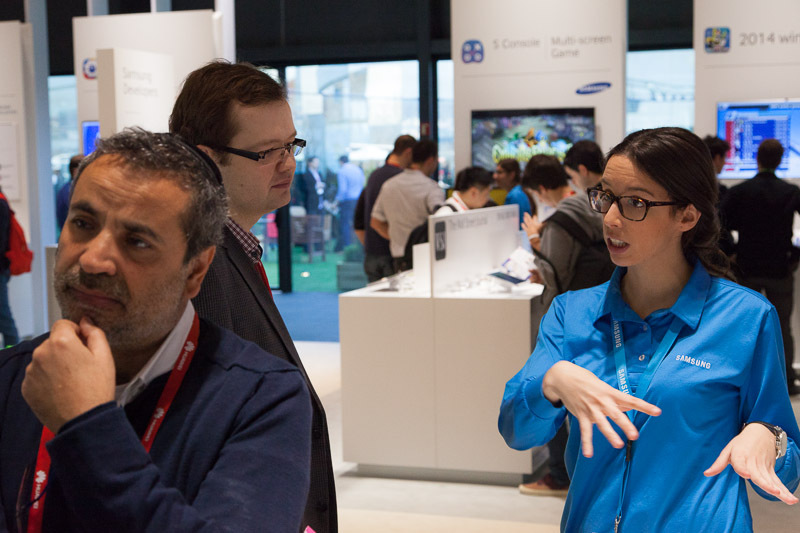
More Samsung Consultants
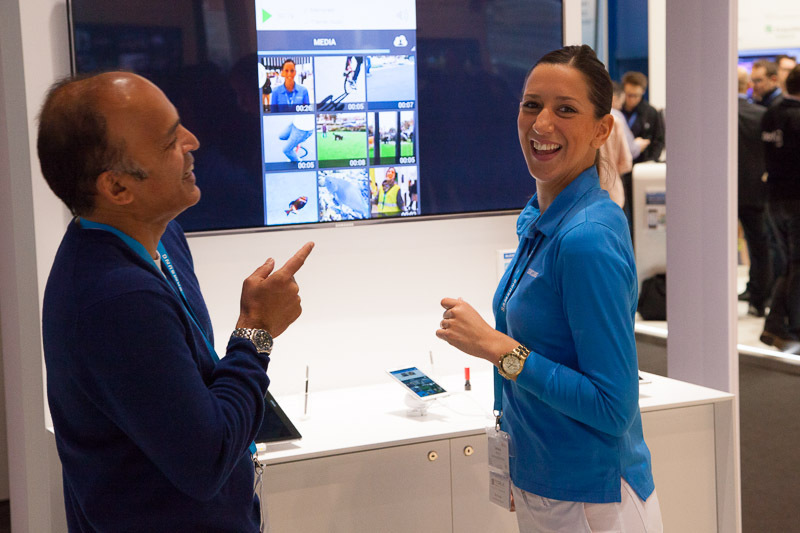
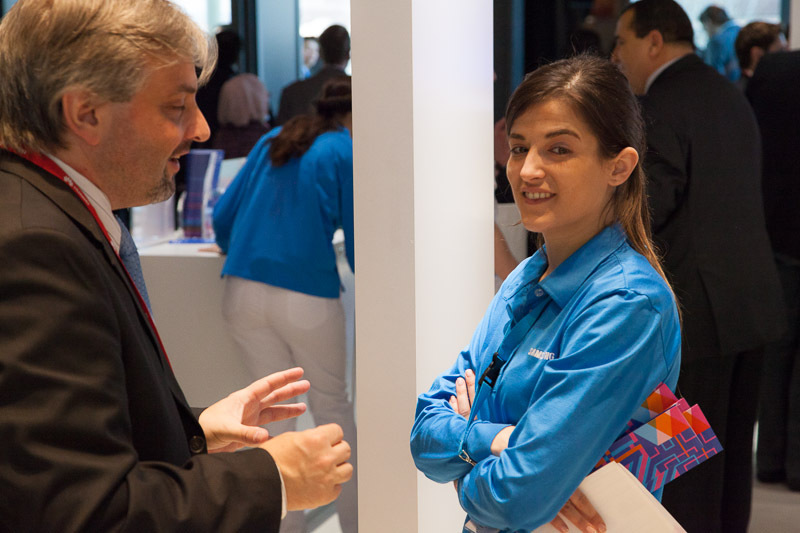

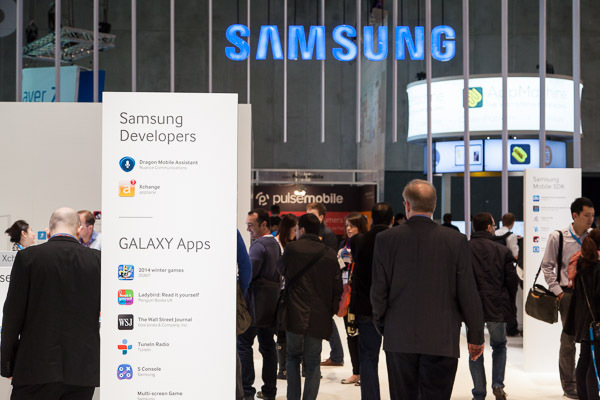





There was also someone to look at in the Intel pavilion (first picture), but these were our organizers, who redirected guests to stands on the subject of interests. If you look at the Intel consultants, you’ll rather tune into a serious mood, because although they look ugly, they will download a lot of technical information and tell you in so many minutes that the audience is perplexed by the fact that Intel produces so much software. In general, there were only boring and abstruse engineers at the stands. Thus, the company shows that the developers will not be left alone, and will always be supported and will receive assistance from specialists at the Intel Developer Zone. Several visitors from companies developing cross-platform high-performance software using native C / C ++ convinced me
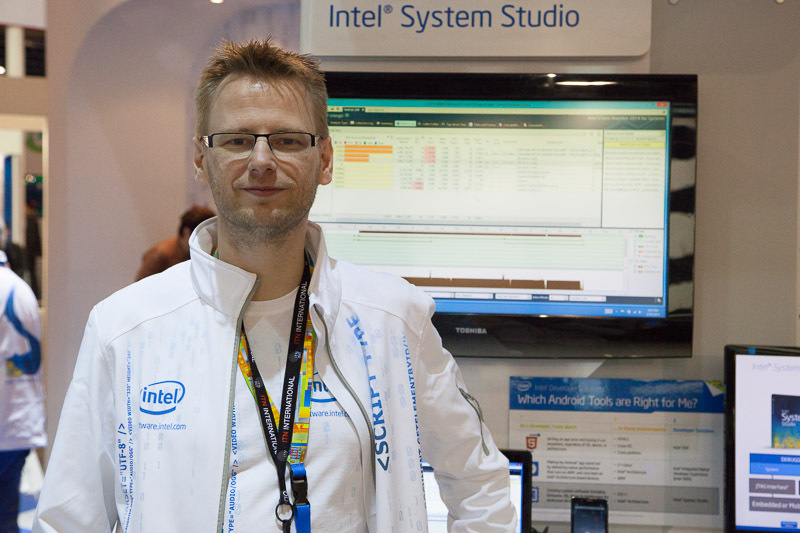
Alex knows almost everything about low-level programming and debugging of the Linux kernel on Android. He advises developers in the Intel Developer Zone.
Reason numbered dos
The quality of applications and services. For a week of travel, I missed my two-month-old daughter. I really wanted to look at her, just as she begins to consciously smile, involuntarily drool and make the first sounds besides “aaaaaaaaa” (dads, I think, will understand me). So, despite the sufficient speed of the channel on both sides, in Skype from my “regular” smartphone I see an image with strange color rendition and terrible sampling, which does not allow us to see fine features, and even with a booming sound.
Example
This is my daughter Maya. She is only two months old, but we communicate via Skype when I'm traveling.

This is my daughter Maya. She is only two months old, but we communicate via Skype when I'm traveling.
I am complaining about this to my colleague, a happy father of two children, about which he leads me to a stand with a demonstration of the new ooVoo video conferencing engine . This project uses hardware encoding, available both on Intel laptops and tablets with SoC Baytrail, and will allow me to see my child in 720p resolution, with excellent sound for the tablet.
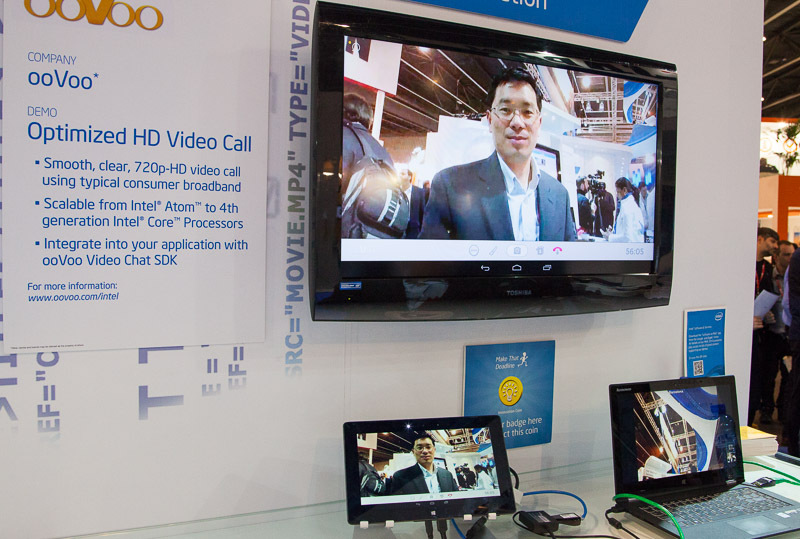
Chen - One of the ooVoo developers is demonstrating a video conference.
On the basis of the Intel pavilion, various applications were demonstrated that, despite the non-unique functionality, provide a much higher quality: if this is a photo from a cell phone, then processed to the “DSLR level”; if the recognition of text and graphics, it works in real time and in business or creative applications; if it is a toy, it does not require poking on the screen, but controlled by gestures.
And finally, the reason for the numbered tras
Enterprise applications also want to work on mobile devices. Chats, social networks and toys, although very common, have already saturated the market. Users do not care what the chip is in their smartphone, and rightly so. But there are applications that do not care. They always existed in the PC world, used the power of Core processors and felt at ease in 64-bit space. Imagine a large enterprise, as usual, with warehouses, invoices, taking into account incoming and outgoing written documentation, reports, protocols, and other logistical pleasures. And all this works under the control of solutions, for example, from SAP or Oracle. So, a huge amount of cost is accounted for by semi-manual input of information, special and just scanners, remote readers, etc. But all this functionality can be placed in a regular smart phone for $ 300, which every employee would have (a camera and an NFC chip as sensors). It is enough to place a front-end application on it, which will perform all the work without special expensive devices, and all specialization will be determined by the software allowed on a particular phone, with access rights, protection and other necessary attributes.
To realize this idea, the smallest detail remained - to port ready-made and optimized x86 applications to ARM. True, not a good idea, as well as porting all the functionality to Java? Yes, you can leave the interface part on the device, and the rest of the functionality can be placed on the servers, but the servers are also expensive, and the applications are already written, and if you could just transfer the native code to the mobile device, just recompiling ... Soon it will be possible. In the news with MWC, much was mentioned about the plans of Qualcomm and others for the release of 64-bit chips. Intel already has ready-made devices on 64-bit processors. And few people paid attention to a modest stand with Intel's 64-bit Android core running on the phone and showing a 15% increase in the performance of ray tracer'a out-of-box. Fifteen percent of none of the MWC visitors are impressed. But in fact, Intel wanted to show that the 64-bit ecosystem already exists, and it includes not only the 64-bit OS with the kernel, drivers and Dalvik virtual machine, but also all the development tools for applications. And while we waitAndroid Art 64-bit, companies lined up for this ecosystem, “who is the last?” in which they ask already far around the corner. Everyone wants to be the first in such a promising market segment.
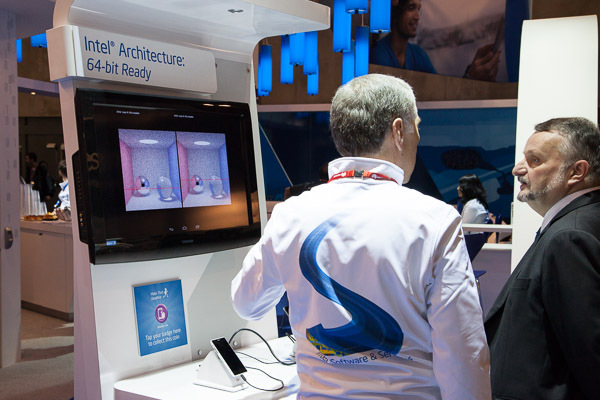
Programmers rarely approached this stand, but often CTO companies.
From my personal experience working with clients, the largest manufacturers of medical logistics solutions dream of abandoning a huge semi-automatic accounting, workflow, special devices, in favor of solutions working on devices that are in the pocket of any employee of a medical institution. All that stopped them so far was the need to port current projects.
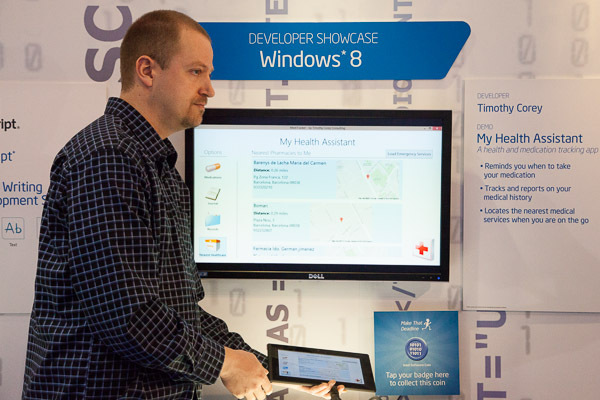
In conclusion, such a remark should be made. It seems to me that Intel is unlikely to enslave the mobile market the way it happened in the world of PCs and servers. Our competitors are great companies that take technology innovation and great products seriously. This makes Intel move and, as an employee, I am glad that due to such a dynamic in the market, we need creative and active people: this means that there are real growth opportunities for specialists in many parts of the corporation.
Well, as a bonus for those who have read to the end:
MWC Pavilion Trekking
Are Qualcomm and Intel side by side accidentally?
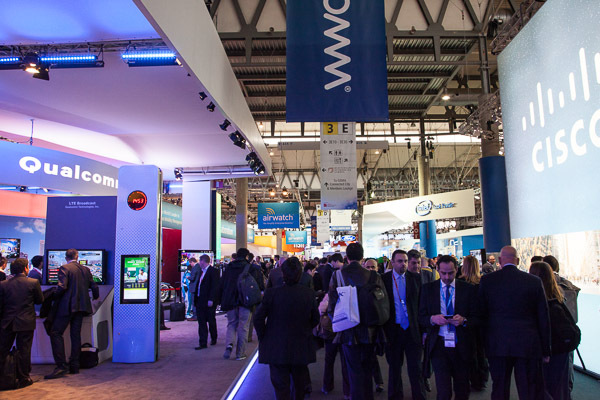
Qualcomm girl wisely does not pretend to be a consultant, but simply poses on the background of a typewriter.

Microsoft-Nokia is showing off its Android phone with a graphical interface similar to Windows Phone. It seems that their grass in the pavilion is not just.

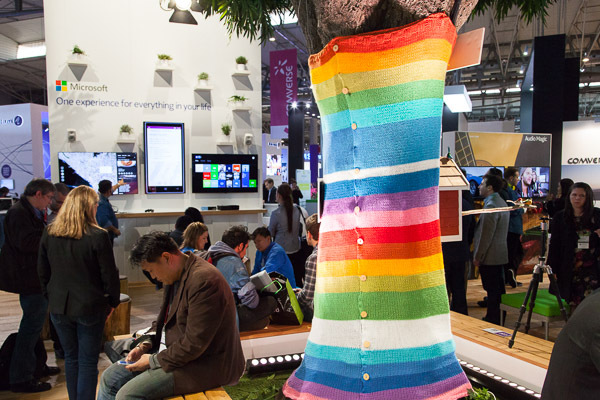
Sony is remembered for its huge 4K panels with amazing quality, receiving a signal from the handheld (though by wire)

Intel surprises with the number of tablets available on its processor. And on the next table it surprises with Android smartphones.
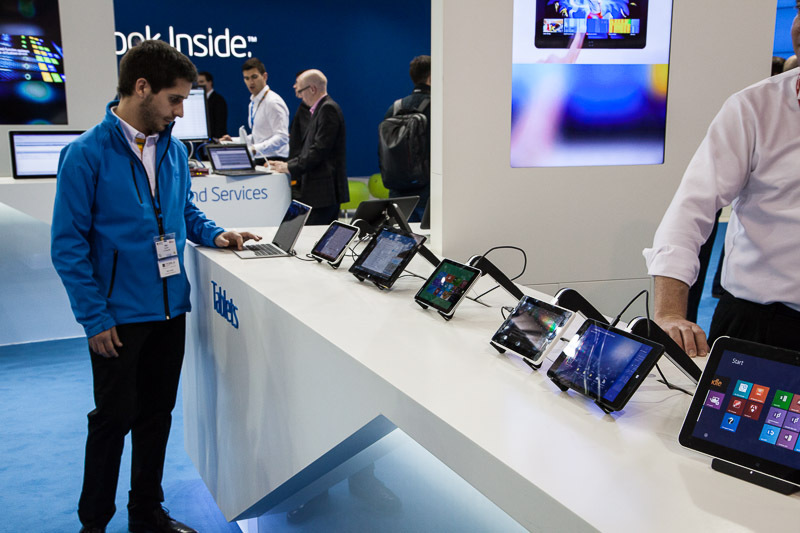
Tizen occupies a separate platform where various vendors of compatible equipment present their achievements.

Well, everyone who went into the Intel pavilion was taken prisoner, and then taught to write native code and optimize for x86.
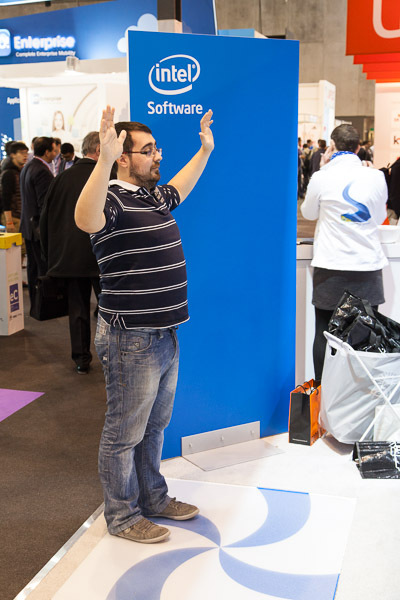

Qualcomm girl wisely does not pretend to be a consultant, but simply poses on the background of a typewriter.

Microsoft-Nokia is showing off its Android phone with a graphical interface similar to Windows Phone. It seems that their grass in the pavilion is not just.


Sony is remembered for its huge 4K panels with amazing quality, receiving a signal from the handheld (though by wire)

Intel surprises with the number of tablets available on its processor. And on the next table it surprises with Android smartphones.

Tizen occupies a separate platform where various vendors of compatible equipment present their achievements.

Well, everyone who went into the Intel pavilion was taken prisoner, and then taught to write native code and optimize for x86.

